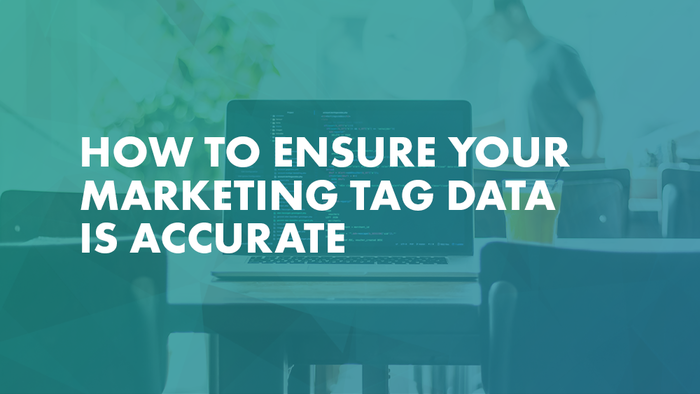Digital media offers unparalleled insight into your customer journey. Where measuring marketing effectiveness was once vague at best, online channels now help us clearly zero in on user behavior, marketing attribution, and opportunities to optimize our online marketing channels.
However, none of these benefits of online media would be available without the means to correctly capture, track, and analyze customer interaction with digital marketing channels. This is where little snippets of computer code called ‘tags’ come in. A small, hidden script on a web page or other digital media, tags provide marketers with the ability to track and monitor customer behavior. The correct placement and operation of these tiny digital servants are key to deriving actionable insights from them.

Why Tag Data Quality is Important
Data quality is the foundation of reliable dashboarding, analysis, reporting, and predictive analytics. To avoid the phenomena of “garbage in, garbage out,” it’s critical to ensure that marketing tags are correctly placed and implemented with appropriate connectivity to the data layer.
Complicating this effort is the proliferation of tags and tagging solutions that were placed on web pages for now-defunct campaigns and were never updated or removed. You need to be sure you have all the tags you need – but only those and no more – and that you’re collecting the right data from the right tags.
A well-thought-out and rigorously implemented tagging strategy is the foundation of successful digital marketing campaigns and marketing attribution. That’s why it’s critical to ensure that your tags generate high quality data for integration with marketing analytics tools.
Understand the Data Layer
The data layer is the digital link that brokers data between tags and back-end systems. It sits between the experience layer (where the user interacts with your site), and the application layer (which is comprised of additional functionality like live chat, personalization, analytics, and display advertising).
The data layer functionality is embedded in the code for a web page and runs when the page is actually rendered in the browser. This is a key point to remember about the data layer: it has to be designed for each unique page type on your site and properly implemented within the HTML source code for those pages. A typical e-commerce site can have multiple page types, meaning the tag for each page has to be designed and implemented for each page type.
Manually developing and managing these tags is challenging at first, and prohibitive over time, as page types and tagging requirements grow and change. This is where tag management tools come in.
Use a Tag Management and Auditing Tool
You need a comprehensive and reliable platform to plan, implement, and audit your tagging strategy. Ideally, this platform should be owned and operated by the marketing team, not IT. IT-centric deployments typically involve a long lead time, are hard to maintain, and don’t provide the agility digital marketers need to modify their tags in time to take advantage of new opportunities.
A well-conceived tag management system should provide an intuitive, graphical user interface that enables digital marketers to deploy or remove tags without having to get into the actual code of a web page or create another service ticket for the IT team.
Once the tags are deployed, a tag auditing system can regularly scan and monitor deployed tags and validate the data generated by user events. More advanced tools enable marketers to define business rules for data collection and validation as well as identify old or broken tags. Some tag auditing systems can take tag audit and data quality management one step further into the discipline of tag governance, which establishes a culture, tools and best practices for end-to-end tag management.
With a tag management tool in hand and data quality capabilities in place, you’re ready to put your tags to work.
Targeted Platforms and Customers Drive Tag Implementation
Your marketing campaign’s mix of analytics and media platforms shed light on where you need to focus your tag development efforts.
- What platforms are in play? Where your target customers spend time online (Facebook, Twitter, Instagram, etc.) helps define the scope of your tag management plan. After all, why would you deploy and manage Google+ specific tags if your campaign wasn’t targeting that platform?
- What are the tagging technical requirements for those platforms? Each marketing technology platform comes with its own nuances and technical complexities, which must be accounted for in tag deployment planning.
- What is our expected traffic by platform? This should drive the number and complexity of tags you should expect to deploy for each platform. For example, if you are expecting 90% of your traffic from Facebook and 10% from Twitter, you should consider this ratio with the number and complexity of tags you deploy for those platforms.
Related to the topic of platform selection is the customer journey. Who are your customers, what path(s) do your buyers take to your site, what do they do while there, and what do they buy and when? With these insights, you can further personalize and target your content to the given customer. As L. Erik Bratt on Martech Today observes, “We can now tag, collect and integrate data from all channels and devices to deliver the right message to the right audience at the right time, no matter where they are.”
This personalization depends on proper deployment and management of marketing tags, which should further specify the types and complexity of tags you select for your site.
Define the Quality Plan
Knowing the number and types of tags by platform sets the stage for tag data quality planning.
- Audit your planned landing pages and remove old or broken tags; deploy all the tags you need to support your campaign’s targeted platforms (but only the tags you really need).
- Use your tag auditing system to ensure your deployed tags are present and working as intended.
- Ensure your tags and data layer components have sufficient uptime.
These last two points are particularly important. If your tags are misfiring or not even loading, it could cause gaps in your tag data and you could be missing valuable insights on customers’ buying behavior.
Test and Optimize
The rigorous application of tag testing best practices can help prevent the aforementioned data gaps and build stakeholder confidence in insights derived from tag data. So how do you ensure your tags are appropriately placed in your target digital media and that they’re properly interacting with the data layer?
As Lucas Long of Tag Inspector explains, tag testing is a three-step process:
- Define the standard to test against. Per your tag policy and architecture, what events should be tracked and what data should be collected from each deployed tag?
- Execute testing against the standard. Some things to look for here include:
- Data layer interaction – Within each tag, what is it referencing in the data layer? Is it referencing the correct parameter?
- CMS changes – If the tag pulls data from its parent page, does that page still capture that data element?
- Tag firing – Is the tag being invoked or “fired” when the page loads or event is executed? If so, are the expected values being captured?
- Timing – Is the tag firing too late in the page load and potentially missing valuable customer events due to users leaving the page?
- Institutionalize testing with monitoring and alerts. With the two items above in place, automated execution of test events can be linked to a monitoring and notification system that fires when a test fails versus the requirements.
In addition to functional testing, don’t underestimate the value of performance testing. That is, even if everything is working as designed and no alerts are being generated, are your tags harming site performance? If so, that could be a problem. According to Sean Work at Kissmetrics:
- 40% of people abandon a website that takes more than 3 seconds to load
- A 1-second delay in page response can result in a 7% reduction in conversions
- If an e-commerce site is making $100,000 per day, a 1-second page delay could potentially cost it $2.5 million in lost sales every year
Inappropriate use of tags could defeat their entire purpose if they degrade site performance to the point that potential buyers give up and go somewhere else.
Again, Lucas provides some insight into how to think about and optimize tag performance in the context of site performance:
- Consider the Client. In this case, “client” means the computer and web browser your target customer uses to access your digital property. The browser is particularly important as it requests page elements and renders the page for the user. Tag optimization considerations include:
- How many connections are possible.
- The anticipated volume of inbound and outbound requests. The number of tags on a page is a factor in the number of requests a browser must make to render the page.
- Contemplate the Connection. Connection refers to the speed and bandwidth of your target users’ internet connection. To address connection concerns:
- Know who your target user is and make fact-based assessments of their connection.
- Sanity check tag size to the target users’ available bandwidth. For example, 100KB of tags going through a 200KB bandwidth connection won’t yield good results.
- Scrutinize the Server. The server houses the webpage code and functionality of your website. The key point to understand about tag performance is latency: how long does it take to fulfill a request from a browser, and is that an acceptable amount of time for your target user?
In summary, be sure to estimate request volume, file size, and latency associated with your tags and determine if they’re acceptable given your target users’ environment and preferences.
To Bring Your Tag Management Solution To Life….
Deploying a tag management system and ensuring data quality is a team effort. The marketing team must put forth the needed subject matter experts and executive sponsor. The IT department provides the development resources and technical project managers to make the site updates. The project must incorporate the data architecture team to define the data pathways and landing zone for the data generated by your tags. Finally, in the likely event you obtain a third-party tag management system solution, vendor personnel should be involved in deployment and support.
In short, there are many different parties and individuals with different incentives and skill sets that must be brought together to drive a tag management system deployment to a successful conclusion.
… Find the “Straddlers”
To help ensure the project runs smoothly and properly accounts for data quality, you need to find a resource that has a foot in both the marketing and IT worlds. Sometimes called “Marketing Technologist” or “Director of Tag Management,” this person is a hybrid marketing/technology expert who can define tagging requirements for the marketing campaign as well as make those requirements actionable for the technology implementation team. This person also needs a strong orientation toward auditing and continuously measuring tag data quality to help ensure this critical phase of the project is seen through to completion and lives on during the life of the deployed tags.
You have a tremendous opportunity to build compelling conversations with your customer through digital media using marketing tags. Ensuring clear, constructive, and ongoing customer conversations requires:
- A thorough understanding of tagging technology
- A clear strategic approach to digital marketing
- A firm grasp of data quality principles
- Deployment blocking and tackling
- Rigorous testing and enhancement of marketing tags
- Ongoing management of deployed tags
Finally, in addition to the above, having the right people implement your tagging solution and related data quality practices is essential to correctly capture the conversation you’re having with your customers.
What are you doing to ensure your marketing tag data is accurate? Share your best tips and tactics in the comments below:



